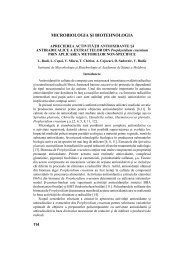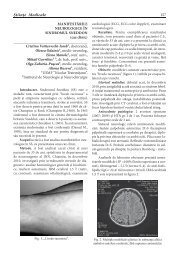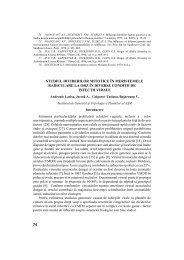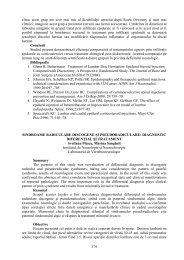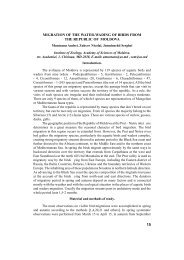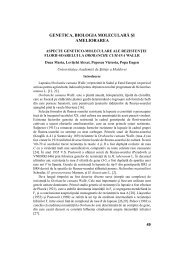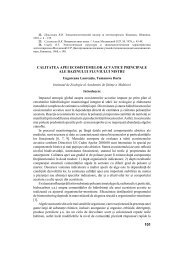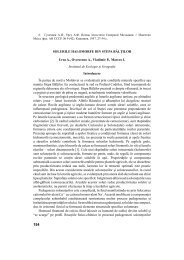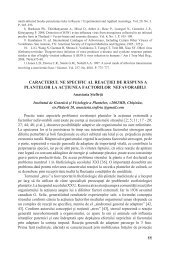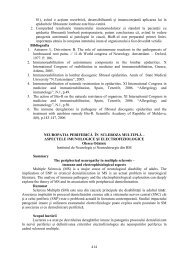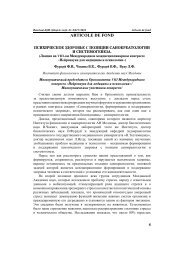BULETINUL ИЗВЕСТИЯ JOURNAL
BULETINUL ИЗВЕСТИЯ JOURNAL
BULETINUL ИЗВЕСТИЯ JOURNAL
You also want an ePaper? Increase the reach of your titles
YUMPU automatically turns print PDFs into web optimized ePapers that Google loves.
Buletinul AŞM. Ştiinţele vieţii. Nr. 3(318) 2012<br />
Fiziologia şi Samocreatologia<br />
to a hot (65°C) solution of 1.95 g (10 mmol) of 2 in 4 mL ethanol. 2 to 4 drops of<br />
glacial acetic acid was added as a catalyst. The resulting mixture was refl uxed at 75°C<br />
for 2h. Then, the solution was allowed to reach ambient temperature and cooled to<br />
0°C overnight. The crude product was fi ltered, dried and recrystallized from ethanol-<br />
DMF solvent mixture. Yield, 2.46 g (85%), m.p. 220°C. 1 H-NMR (DMSO-d 6 ) δ: 2.19<br />
(s, 3H, o-CH 3 ); 2.30 (s, 3H, p-CH 3 ); 7.02, 7.08, 7.15 (m, 3H, phenyl); 8.17 (s, 1H,<br />
azomethine); 7.59, 7.84, 7.96 (m, 3H, thiophenyl); 9.81 (s, 1H, C Ph –NH); 11.69 (s,<br />
1H, NH–N=). 13 C-NMR (DMSO-d 6 ) δ: 18.23 (o-CH 3 ); 21.11 (p-CH 3 ); 126.89, 131.07,<br />
135.54, 135.97, 136.20, 138.07 (phenyl); 126.24 (azomethine); 127.54, 128.49, 128.96<br />
(thiophenyl), 177.29 (C=S).<br />
N -( 2 , 4 - d i m e t h y l p h e n y l) - 2 -( q u i n o l i n e - 2 - y l m e t h y l e n e)<br />
hydrazinecarbothioamide (7): 1.73 g (11 mmol) of 2-formylquinoline was added to<br />
a hot (65°C) solution of 1.95 g (10 mmol) of 2 in 4 mL ethanol. 2 to 4 drops of glacial<br />
acetic acid was added as a catalyst. The resulting mixture was refl uxed at 75°C for<br />
2h. Then, the solution was allowed to reach ambient temperature and cooled to 0°C<br />
overnight. The crude product was fi ltered, dried and recrystallized from ethanol-DMF<br />
solvent mixture. Yield, 2.87 g (86%), m.p. 208°C. 1 H-NMR (DMSO-d 6 ) δ: 2.22 (s, 3H,<br />
o-CH 3 ); 2.31 (s, 3H, p-CH 3 ); 7.05, 7.11, 7.14 (m, 3H, phenyl); 8.34 (s, 1H, azomethine);<br />
7.63, 7.78, 7.98, 8.04, 8.37, 8.63 (m, 6H, quinolyl); 10.22 (s, 1H, C Ph –NH); 12.15 (s,<br />
1H, NH–N=). 13 C-NMR (DMSO-d 6 ) δ: 18.24 (o-CH 3 ); 21.12 (p-CH 3 ); 118.87, 127.04,<br />
130.38, 135.85, 136.54, 136.68 (phenyl); 143.08 (azomethine); 119.6, 127.0, 128.3,<br />
128.9, 129.9, 130.9, 136.5, 148.5, 149.3 (quinolyl), 177.89 (C=S)<br />
N-(2,4-dimethylphenyl)-2-(2-hydroxybenzylidene)hydrazinecarbothioamide<br />
(8): 1.23 g (11 mmol) of salicylaldehyde was added to a hot (65°C) solution of 1.95<br />
g (10 mmol) of 2 in 4 mL ethanol. 2 to 4 drops of glacial acetic acid was added as a<br />
catalyst. The resulting mixture was refl uxed at 75°C for 2h. Then, the solution was<br />
allowed to reach ambient temperature and cooled to 0°C overnight. The crude product<br />
was fi ltered, dried and recrystallised from ethanol-DMF solvent mixture. Yield, 2.66<br />
g (89%), m.p. 187-188°C. 1 H-NMR (DMSO-d 6 ) δ: 2.18 (s, 3H, o-CH 3 ); 2.29 (s, 3H,<br />
p-CH 3 ); 7.01, 7.07, 7.15 (m, 3H, phenyl); 8.47 (s, 1H, azomethine); 6.82, 6.88, 7.23,<br />
8.07 (m, 4H, hydroxyphenyl); 9.82 (s, 1H, OH); 9.95 (s, 1H, C Ph –NH); 11.69 (s, 1H,<br />
NH–N=). 13 C-NMR (DMSO-d 6 ) δ: 18.18 ( o-CH 3 ); 21.06 ( p-CH 3 ); 119.69, 126.84,<br />
131.09, 133.62, 135.36, 136.00 (phenyl); 140.42 (azomethine); 117.82, 118.58, 121.43,<br />
127.52, 136.18, 156.99 (hydroxyphenyl), 177.31 (C=S).<br />
Results and discussion<br />
Antileukaemia activity. Six of the synthesized compounds were tested as inhibitors of<br />
HL-60 cells proliferation. These human promyelocytic leukaemia cells were incubated<br />
for three days in the presence of synthetic compounds and the number of viable cells<br />
was measured using the MTS assay (Scheme 2).<br />
The results are expressed as the percentage of cell growth inhibition at three<br />
concentrations (Table 1). As it can be concluded from the data above, N-(2,4dimethylphenyl)<br />
hydrazinecarbothioamide 2 has a pretty low antiproliferative activity.<br />
Thereby, at the concentration of 0.1 μM 2 shows its highest activity, almost equal to<br />
that of Doxorubicin at the same concentration. Thiosemicarbazones 4 and 5 do not<br />
inhibit cell proliferation at any concentration.<br />
63



